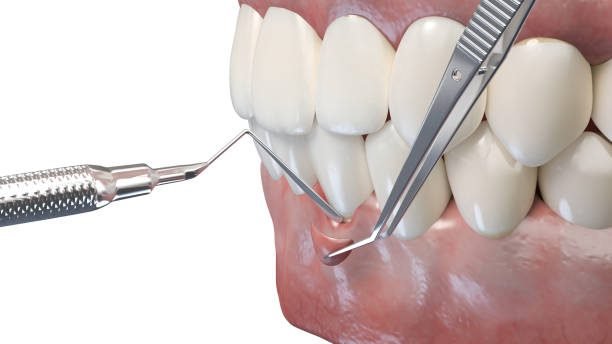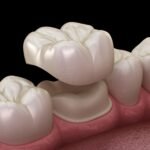Table of Contents
Understanding Crown Lengthening: What You Need to Know

Crown lengthening is a dental procedure that is commonly used to treat a variety of oral health issues. It involves the removal of gum tissue and sometimes bone to expose more of the tooth’s surface. This procedure can be performed for aesthetic reasons, such as to create a more even smile or to address a “gummy” appearance. However, it can also be done for functional reasons, such as to provide better access for a dental restoration or to treat gum disease.
During a crown lengthening procedure, a periodontist will carefully evaluate the patient’s oral health and determine the appropriate amount of tissue to remove. This evaluation includes assessing the health of the gums and bone, as well as evaluating the tooth structure and alignment. Once the evaluation is complete, the patient will be given a thorough explanation of the procedure and what to expect during and after the surgery. It is important for patients to understand that crown lengthening is a surgical procedure and, as with any surgery, comes with some risks and a recovery period. Nonetheless, many patients find that the benefits of crown lengthening, including improved dental aesthetics and functionality, far outweigh any potential risks.
The Benefits of Crown Lengthening: Aesthetic and Functional Improvements

Crown lengthening is a dental procedure that offers both aesthetic and functional benefits. On the aesthetic front, it can help enhance the appearance of your smile by improving the proportion and symmetry of your teeth. By removing excess gum tissue and exposing more of the tooth’s surface, crown lengthening can create a more balanced and pleasing smile. This procedure can also be beneficial for individuals with a “gummy smile” where an excessive amount of gum tissue is visible when smiling, making the teeth appear shorter or disproportionate.
In addition to its aesthetic advantages, crown lengthening also provides functional improvements. By exposing more of the tooth’s surface, it allows for better access during restorative procedures like dental crowns, bridges, or veneers. This increased visibility and access enable dentists to achieve more precise and predictable results in terms of fitting the restorations and ensuring a proper bite alignment. Moreover, crown lengthening can benefit individuals with extensive tooth decay or fractures below the gum line, as it allows for easier access for the necessary dental treatments, ultimately leading to improved oral health and function.
The Initial Consultation: Meeting with the Periodontist

During your initial consultation for crown lengthening, you will have the opportunity to meet with a professional in the field of periodontics, specifically a periodontist. This meeting is crucial in order to fully understand the process and determine if crown lengthening is an appropriate treatment option for you.
The periodontist will begin the consultation by taking the time to thoroughly evaluate your oral health and discuss your dental concerns and goals. This may involve a comprehensive examination of your gums, teeth, and supporting structures, as well as reviewing any relevant medical history. Additionally, the periodontist may request X-rays or other diagnostic imaging to gain a more detailed understanding of your dental anatomy.
Furthermore, the consultation provides an opportunity for you to ask questions and address any concerns you may have. The periodontist will explain the crown lengthening procedure, including its benefits, potential risks, and alternative treatment options. It is important to openly communicate your expectations and desired outcome, as this will help the periodontist create a personalized treatment plan that aligns with your individual needs and goals.
The Importance of Pre-treatment Evaluation: Assessing the Health of Your Gums
Assessing the health of your gums is a crucial step in the pre-treatment evaluation for crown lengthening. This process allows the periodontist to thoroughly examine your gums and determine their overall condition. The evaluation involves a comprehensive assessment of various factors, including gum disease, gum recession, and the presence of any underlying oral health issues.
One of the primary objectives of this evaluation is to assess the presence and severity of gum disease. Gum disease, also known as periodontal disease, is a common oral health condition that affects the tissues surrounding the teeth. If left untreated, gum disease can lead to the deterioration of the gums and supporting structures, which can ultimately impact the success of crown lengthening procedures. By evaluating the health of your gums, the periodontist can determine the extent of any existing gum disease and develop an appropriate treatment plan, if necessary.
Additionally, the pre-treatment evaluation allows the periodontist to assess the level of gum recession. Gum recession refers to the gradual lowering of the gum line, which can expose the tooth roots and compromise the aesthetics of your smile. During this evaluation, the periodontist will carefully examine the position of your gums and assess the amount of recession present. This information helps determine the extent of the crown lengthening procedure required to restore a balanced and harmonious gum line, promoting both functional and aesthetic improvements.
Overall, the importance of a pre-treatment evaluation cannot be overstated. By thoroughly assessing the health of your gums, the periodontist can tailor the crown lengthening procedure to your specific needs and ensure optimal results. This evaluation sets the stage for a successful treatment plan and plays a crucial role in achieving a beautiful, natural smile.
Preparing for Crown Lengthening Surgery: What to Expect
Crown lengthening surgery is a common procedure recommended by dentists and periodontists to treat various dental issues. If you are undergoing this surgery, it is important to understand what to expect before, during, and after the procedure.
Before the surgery, your periodontist will conduct a thorough examination to assess your oral health. This may include X-rays, dental impressions, and measurements to determine the extent of crown lengthening required. Your periodontist will also discuss your medical history, allergies, and any medications you are currently taking to ensure your safety during the procedure. It is essential to follow any pre-operative instructions given by your periodontist, such as avoiding food and drink for a specific period of time before the surgery. Additionally, you may be prescribed antibiotics or mouth rinses to minimize the risk of infection.
The Surgical Procedure: An Overview of the Process
During the crown lengthening surgery, the periodontist will begin by administering local anesthesia to numb the area. This ensures that the patient remains comfortable throughout the procedure. Once the anesthesia takes effect, the periodontist will carefully make incisions in the gum tissue surrounding the tooth or teeth being treated. These incisions expose the underlying bone and allow the periodontist to access the tooth structure more easily.
Next, the periodontist will gently reshape the gum tissue and remove any excess or damaged gum tissue, as well as a small portion of the bone if necessary. This process helps to create a more proportionate and symmetrical appearance of the teeth. The periodontist will then thoroughly clean the surgical site and suture the gum tissue back into place using fine sutures. These sutures promote healing and help to secure the gum tissue in its new position.
At the end of the procedure, the periodontist may place a temporary protective dressing over the surgical site to aid in the healing process. This dressing helps to protect the area and prevent infection. The entire surgical procedure typically takes about one to two hours, depending on the complexity of the case and the number of teeth being treated. After the surgery, the patient will receive detailed instructions for post-operative care and will be scheduled for follow-up appointments to monitor progress and make any necessary adjustments.
Recovery and Post-operative Care: Taking Steps Towards Healing
Following crown lengthening surgery, proper post-operative care is crucial for a smooth and successful recovery. Taking steps towards healing will help minimize discomfort, reduce the risk of complications, and promote optimal oral health. Here are some important guidelines to follow during the recovery period.
1. Managing Discomfort: It is normal to experience some discomfort, swelling, and mild pain after crown lengthening surgery. Your periodontist may prescribe pain medication to alleviate these symptoms. Additionally, applying an ice pack to the affected area can help reduce swelling. It is important to follow the recommended dosage and instructions provided by your periodontist.
2. Maintaining Oral Hygiene: Good oral hygiene practices are essential to ensure proper healing and prevent infection. However, it is important to be gentle while brushing and flossing around the surgical site to avoid any trauma to the gums. A soft-bristled toothbrush and a saltwater rinse can be used to keep the area clean. Your periodontist may also suggest an antimicrobial mouthwash to minimize the risk of infection.
By following these post-operative care instructions, you can support the healing process and achieve the best results from your crown lengthening surgery. It is crucial to attend all follow-up appointments with your periodontist to monitor progress and address any concerns that may arise. With proper care and attention, you can look forward to a beautiful and healthy smile.
Here’s a comprehensive guide on recovery and post-operative care to facilitate healing after surgery:
| Recovery and Post-operative Care: Taking Steps Towards Healing | Guidelines |
|---|---|
| 1. Follow Doctor’s Instructions | – Adhere strictly to the post-operative instructions provided by your surgeon or healthcare provider. |
| – Follow medication schedules, dietary restrictions, and activity limitations outlined for your specific procedure. | |
| 2. Manage Pain and Discomfort | – Take prescribed pain medications as directed to manage post-operative pain. |
| – Use ice packs or cold compresses to reduce swelling and discomfort, following the recommended schedule. | |
| 3. Monitor Surgical Wound | – Keep the surgical site clean and dry as per instructions. |
| – Monitor for signs of infection such as increased redness, swelling, warmth, drainage, or fever, and report any concerns to your healthcare provider promptly. | |
| 4. Maintain Proper Nutrition and Hydration | – Follow a balanced diet rich in nutrients to support healing and recovery. |
| – Stay hydrated by drinking plenty of water unless otherwise advised by your healthcare provider. | |
| 5. Rest and Avoid Strenuous Activities | – Allow your body ample time to rest and recover by avoiding strenuous activities and heavy lifting. |
| – Gradually resume normal activities as tolerated, following your surgeon’s recommendations. | |
| 6. Attend Follow-up Appointments | – Attend all scheduled follow-up appointments with your surgeon or healthcare provider for wound assessment and monitoring of healing progress. |
| – Discuss any concerns or issues with your recovery during these appointments. | |
| 7. Practice Proper Wound Care | – Follow instructions for wound care provided by your surgeon, including dressing changes, wound cleansing, and avoiding exposure to water as directed. |
| – Report any changes in wound appearance or any unusual symptoms to your healthcare provider immediately. | |
| 8. Manage Emotional Well-being | – Be mindful of your emotional well-being during the recovery process. |
| – Reach out to friends, family, or mental health professionals for support if you experience feelings of anxiety, depression, or other emotional challenges. | |
| 9. Avoid Smoking and Alcohol | – Refrain from smoking or using tobacco products, as they can impair healing and increase the risk of complications. |
| – Limit alcohol consumption, as it can interfere with medications and negatively impact healing. | |
| 10. Practice Gentle Physical Activity | – Engage in light physical activity such as walking or gentle stretching as tolerated to promote circulation and prevent stiffness. |
| – Avoid high-impact or strenuous exercises until cleared by your healthcare provider. |
Managing Discomfort: Tips for a Smooth Recovery
After undergoing crown lengthening surgery, it is common to experience some discomfort during the recovery period. While everyone’s pain tolerance and healing process may vary, there are several tips that can help ensure a more comfortable and smooth recovery.
First and foremost, it is crucial to follow any post-operative instructions provided by your periodontist. This may include taking prescribed medications to manage pain and prevent infection. It is important to take these medications as directed and not exceed the recommended dosage. Additionally, applying ice packs to the affected area can help reduce swelling and alleviate discomfort. It is recommended to apply the ice for about 15 minutes every hour for the first 24 hours post-surgery. Remember to always wrap the ice pack in a cloth or towel to prevent direct contact with the skin.
Maintaining good oral hygiene is essential for a smooth recovery. While it is important to continue brushing your teeth, you should avoid brushing the surgical site for the first few days. Instead, gently rinse your mouth with a warm saltwater solution multiple times a day, as recommended by your periodontist. This will help keep the area clean and promote healing. Additionally, it is advisable to stick to a soft food diet during the first few days to minimize irritation and discomfort. Opt for softer options such as soups, yogurt, mashed potatoes, and smoothies.
By following these tips and closely following the guidance of your periodontist, you can manage discomfort and promote a smoother recovery after crown lengthening surgery.
Follow-up Appointments: Monitoring Progress and Adjustments
During follow-up appointments after crown lengthening surgery, your periodontist will closely monitor your progress and make any necessary adjustments to ensure optimal healing and long-term success. These appointments are crucial in assessing the healing of your gums and bone, as well as the fit of your temporary or permanent crown.
One of the main objectives of follow-up appointments is to evaluate the healing process. Your periodontist will carefully assess the condition of your gums and bone to ensure that they are healing properly. They will check for any signs of infection, inflammation, or complications that may require additional intervention. X-rays may also be taken to evaluate the bone structure and the integration of the crown into the surrounding tissues.
The Final Results: Revealing a Beautiful and Natural Smile
Following a successful crown lengthening procedure, patients can experience the joy of revealing a beautiful and natural smile. The final results are truly transformative, enhancing both the aesthetic appearance and functionality of the teeth. With the excess gum tissue removed, patients can enjoy a more balanced, symmetrical smile, showcasing the full length of their teeth.
One of the key benefits of crown lengthening is the ability to correct a “gummy smile,” where excessive gum tissue covers a significant portion of the teeth. By exposing more tooth structure, the smile appears more proportionate and aesthetically pleasing. This simple change can have a significant impact on a person’s overall self-confidence and willingness to show off their smile.
Not only does the final result of crown lengthening improve the cosmetic aspect of a smile, but it also facilitates better oral hygiene practices and overall oral health. With the gum line properly adjusted and the tooth structure more accessible, patients can clean their teeth more effectively, reducing their risk of gum disease and decay. Additionally, the enhanced tooth exposure allows for a more secure and stable foundation for future dental restorations, such as dental crowns or bridges.
Crown lengthening truly presents a remarkable transformation, unveiling a beautiful, natural smile that boosts one’s self-esteem and offers long-lasting oral health benefits.
Maintaining Oral Health after Crown Lengthening: Tips for Long-term Success
Maintaining oral health after crown lengthening is crucial for the long-term success of the procedure. Following a few simple tips can help ensure that your smile remains healthy and beautiful for years to come.
First and foremost, it is essential to continue practicing good oral hygiene. Brushing your teeth twice a day with a soft-bristled toothbrush and fluoride toothpaste is vital. Don’t forget to carefully clean along the gumline where bacteria can accumulate. Incorporating daily flossing into your routine is equally important as it removes plaque and food particles from between the teeth and gums. Additionally, using an antimicrobial mouth rinse can help kill bacteria and freshen your breath.
Secondly, regular visits to your dentist for check-ups and professional cleanings are crucial. Your dentist will assess the health of your gums, monitor your healing progress, and address any concerns that may arise. They may also recommend additional treatments or interventions, such as the use of antimicrobial agents or oral antibiotics, to optimize your healing process.
By diligently maintaining oral hygiene practices and attending regular dental appointments, you can ensure the long-term success of your crown lengthening procedure. Taking these steps will not only preserve the health of your gums but also contribute to a more confident and radiant smile.
Smile Transformation: The Emotional Impact of Crown Lengthening
Crown lengthening is a procedure that can have a significant emotional impact on individuals seeking a smile transformation. Many people with a “gummy” smile or uneven gum line may feel self-conscious about their appearance and avoid smiling or speaking confidently. Crown lengthening can address these concerns by creating a more balanced and aesthetically pleasing smile.
Beyond the physical changes, the emotional impact of crown lengthening can be profound. Patients often report an increase in self-esteem and confidence, as they no longer feel the need to hide their smile. This newfound self-assurance can have a positive ripple effect in various aspects of their lives, from personal relationships to professional opportunities. By improving the aesthetics of their smile, crown lengthening can empower individuals to present themselves with pride and embrace their true selves.
Empowering Others: Sharing My Experience and Encouraging Confidence
Sharing personal experiences and encouraging confidence can have a profound impact on others who are considering crown lengthening. By openly discussing my own journey, I aim to empower individuals, helping them make informed decisions about their oral health and ultimately boosting their self-esteem.
Through my own experience, I have come to realize the transformative power that crown lengthening can have on one’s smile. Not only did it enhance the aesthetic appeal of my teeth, but it also provided significant functional improvements, allowing for improved oral hygiene and overall oral health. By sharing these benefits, I hope to inspire others to take control of their dental health and explore the possibilities that crown lengthening offers.
Confidence is a vital component of a fulfilling life, and it begins with feeling comfortable and proud of our smiles. By sharing my personal journey and discussing the positive impact that crown lengthening had on my self-confidence, I hope to empower others to take that step towards achieving the smile they have always desired. Through education and support, we can together create a community that prioritizes oral health and embraces the transformative potential of dental procedures like crown lengthening.
What is crown lengthening and why is it necessary?
Crown lengthening is a surgical procedure performed by a periodontist to expose more of the tooth structure by removing excess gum tissue or bone. It may be necessary for functional reasons, such as to make room for a dental crown or to access decay below the gumline, or for aesthetic purposes, to create a more balanced and proportionate smile.
How long does the crown lengthening procedure take?
The duration of the crown lengthening procedure can vary depending on the complexity of the case and the number of teeth involved. On average, it may take anywhere from 30 minutes to 2 hours.
Will crown lengthening surgery be painful?
The periodontist will administer local anesthesia to numb the area, ensuring that you will not feel any pain during the surgery. However, there may be some discomfort or soreness after the procedure, which can be managed with over-the-counter pain medication.
How long does it take to recover from crown lengthening surgery?
The initial healing period after crown lengthening surgery typically takes about 1-2 weeks. However, complete healing of the gums and bone may take several months. It is important to follow the post-operative care instructions provided by your periodontist to promote a smooth and speedy recovery.
Is crown lengthening permanent?
The effects of crown lengthening are considered to be permanent, as the excess gum tissue and bone removed during the procedure will not grow back. However, it is important to maintain good oral hygiene practices and regular dental check-ups to ensure the long-term success and health of your gums.
Can crown lengthening be done on any tooth?
Crown lengthening is typically performed on the front teeth, but it can also be done on any tooth that requires additional tooth structure exposure for functional or aesthetic reasons. Your periodontist will evaluate your specific case and determine if crown lengthening is the appropriate treatment option for you.
Will my insurance cover the cost of crown lengthening surgery?
Insurance coverage for crown lengthening surgery may vary depending on your dental insurance plan and the specific reasons for the procedure. It is advisable to contact your insurance provider ahead of time to inquire about coverage and any pre-authorization requirements.
What are the potential risks or complications associated with crown lengthening?
Like any surgical procedure, crown lengthening carries some risks, although they are generally minimal. These may include infection, excessive bleeding, and temporary tooth sensitivity. Your periodontist will discuss potential risks and complications with you prior to the surgery and take all necessary precautions to minimize them.
How soon can I eat normally after crown lengthening surgery?
It is advisable to stick to a soft or liquid diet for the first few days after surgery to allow the gums to heal properly. Your periodontist will provide specific dietary recommendations based on your individual case. Gradually, you can reintroduce solid foods as your comfort level allows.
Can crown lengthening improve the appearance of my smile even if I don’t need a dental crown?
Yes, crown lengthening can enhance the appearance of your smile even if you don’t require a dental crown. By exposing more of your tooth structure, it can create a more balanced and proportionate smile, improving your overall aesthetic appearance.











